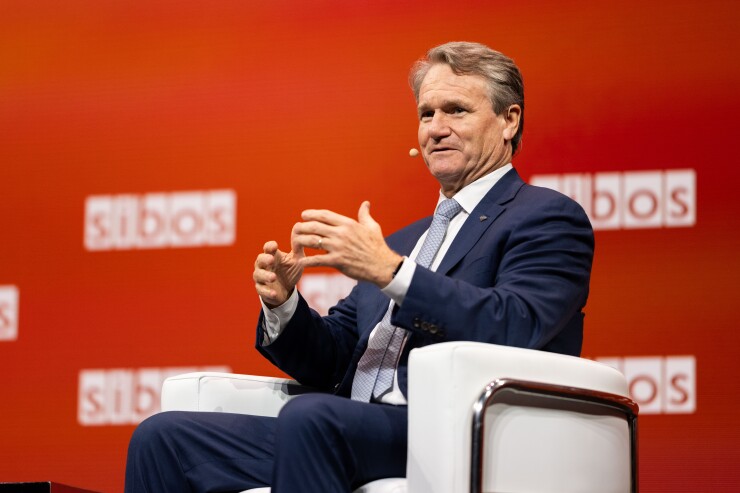Banks and other financial organizations are emphasizing practical use cases for artificial intelligence and cautioning against the distractions of "shiny objects."
"Thinking we have a new toy and what can we do — that's the wrong question," said Mark Gould, chief payments executive for the Federal Reserve System, at a panel at Sibos, the global financial services conference organized by payment messaging service Swift. "Think of the business problem: What are we trying to solve?"
Some banks in attendance at Sibos shared the use cases they have put into practice in securities services and corporate banking.
In the conference's opening plenary, Brian Moynihan, CEO of Bank of America, announced an upgrade to CashPro, the bank's digital platform for payments, receipts, liquidity, investments, FX and trade. The CashPro Chat virtual assistant now includes the same proprietary AI and machine learning behind Erica, the bank's retail-oriented virtual assistant.
Still, Bank of America is in the early stages of exploring
"The idea of having models work on data and information, that is not new," Moynihan said of generative AI. "The idea of having it run on its own and learn from itself, that is different."
Financial institutions must adopt generative AI and large language models, or risk falling behind, experts said.
In a separate panel on the impact of technology and data intelligence on financial services, which included Gould, banks detailed the features and services they are implementing.
Bruno Campenon, the global head of financial intermediaries and corporates at BNP Paribas, said the bank has more than 500 use cases incorporating artificial intelligence, including predictive analytics for transactions and models the bank trained to read prospectuses.
"The purpose of AI is to take unstructured data, structure it, analyze it and ultimately create a model around it. That's what we're trying to apply in each and every use case that we do," he said.
Cathinka Wahlstrom, the chief commercial officer of BNY Mellon, estimates the bank has hundreds of proposed use cases involving AI underway. One that is up and running is a patent-pending solution that deploys predictive analytics to gauge in advance whether a trade settlement will fail, giving its clients time to resolve the issues. In July, the bank launched
Gould, of the Federal Reserve System, expects that fraud mitigation and customer support could be among the agency's first use cases.
"We're focused on building the skill across our organization, from governors to senior leaders to analysts and entry level employees, to first educate ourselves, and then experimenting," he said. "I'm a big believer that we learn by doing."
Katrina Stuart, general manager of business payments at
When considering the skills she needs to hire for, "it's people who understand the technologies but also the real business applications of them, rather than getting caught up in the latest shiny new toy," she said on the panel. "How can we use the technology to transform, particularly from a payments perspective, what the customer experience is going to be?"
Panelists also spoke of the importance of collaboration in keeping up with emerging technologies.
"With all the stuff going on out there, with cybersecurity, the need for frictionless payments, the need to connect payment systems that weren't necessarily connected — collaboration among participants allows us to let that happen," said Moynihan in the opening plenary.
BNY Mellon has a multipronged strategy, from participating in fintech accelerators to strategic investments to co-creation partnerships. For example, in December 2022, BNY Mellon led the $14 million investment round for front office investment technology firm BondIT.
Gould has met with more fintechs in the last 12 months than in the previous five years.
"I see great potential in fintechs being an enabler of connectivity," especially with the adoption of instant payments, he said. "They're smaller, they tend to be a bit more agile, they can be more iterative and they tend to be pretty focused on a particular use case."
Stuart has seen a similar pattern emerge in Australia.
"They've been the drivers of innovation that we've seen in the marketplace," she said. "What's interesting is we're starting to see more collaboration with some banks, because they're seeing opportunities to come together and deliver better solutions. It's a win-win for everybody."







